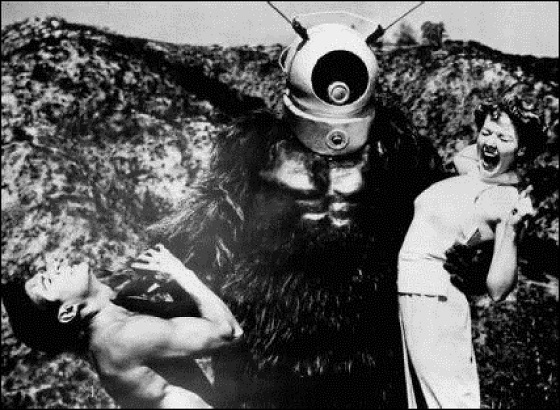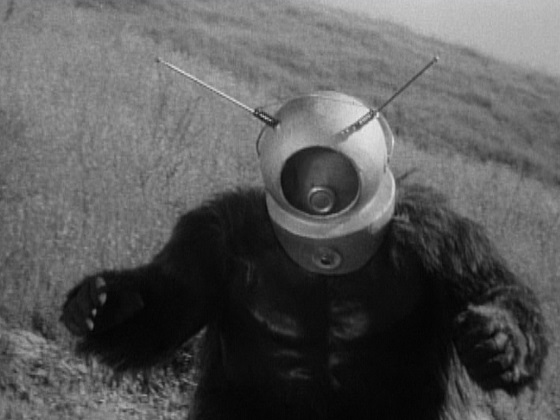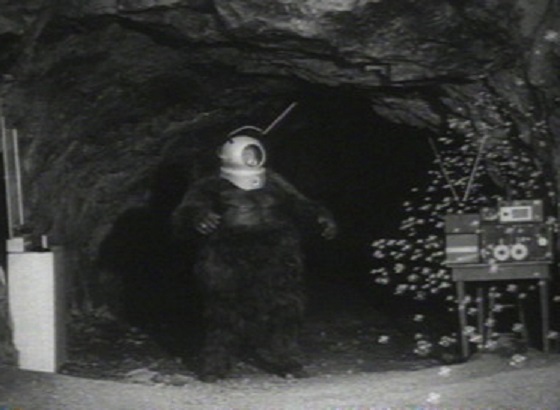There are bad movies, and then there are Bad Movies. The first category includes movies that in some way are just inferior films, with little or no entertainment value. The second category, capital B and M Bad Movies, are movies that have substantial flaws and are universally loved in spite, or maybe even because, of them. Filmmakers like Ed Wood and Roger Corman have built entire careers out of making schlocky films, and the trend continues with modern movies like Showgirls and The Room. Although the title of Worst of the Worst is highly debatable, a film that is definitely in the running for the honor of the King of the Bad Movies is 1953’s alien invasion disaster Robot Monster.

Robot Monster begins with a young boy named Johnny (Saddle Tramp’s Gregory Moffett) playing out in the desert with his sister, Carla (Pamela Paulson in her only film credit). They come across their father, an archaeologist known only as The Professor (Captain Scarface’s John Mylong), and his assistant, Roy (George Nader from The Human Duplicators and Appointment with a Shadow), working in a cave. They are soon joined by the children’s mother, Martha (Selena Royale from Main Street After Dark), and older sister, Alice (A Life at Stake’s Claudia Barrett), and all of them go back to the house for lunch. Suddenly, Earth is hit by a Calcinator Death Ray, an intergalactic weapon that wipes out all life on the planet. The Professor’s family is spared because of an experimental antibiotic serum that they have all taken that has accidentally saved their lives. Unfortunately for them, a half-ape, half-robot alien called Ro-Man has come down to Earth to survey the planet and discovers the survivors. Ro-Man communicates his findings with his leader, a similar looking alien named The Great Guidance, who tells him that he must destroy the leftover people himself by force, explaining to him that “humans have gotten too intelligent” and that “Earth is our only rival.” Ro-Man sets out to kill the humans, but his plan is derailed when he meets the beautiful Alice, whom he is immediately smitten with. Roy also has feelings for Alice, and he and The Professor will stop at nothing to protect the family from the monstrous alien.

Despite the universal belief that it is a bad movie, Robot Monster was made so cheaply that it was still considered a success by Hollywood standards. The film, written by Wyott Ordung (First Man Into Space), was directed by Phil Tucker (The Cape Canaveral Monsters) in four days for less than $20,000, and would go on to gross over a million dollars domestically. Add in all of the cult status attention that the film has received since its initial release, and Robot Monster can be viewed as quite an accomplishment. Camp and kitsch may not have been the type of publicity that the filmmakers had set out to attain, but that’s what they got, and Robot Monster is a film that is near and dear to the hearts of b-movie fans everywhere.

The signature role of Ro-Man in Robot Monster was performed by two different men, both of whom also played Ro-Man’s leader, The Great Guidance. The simple part, the voice duties of the alien, were handled by John Brown (Strangers on a Train), while the fun half of the performance fell onto the shoulders of professional gorilla actor George Barrows, who made a career out of playing apes in everything from Gorilla at Large and The Ghost in the Invisible Bikini to “The Incredible Hulk” and “The Lucy Show.” Barrows, a personal friend of director Phil Tucker, hand-made his own gorilla suit and carved his niche in Hollywood playing simian roles. He brought his costume to the set and Tucker fitted it with a space helmet to give it a more alien look. The result is one of the most recognizable icons of Bad Science Fiction ever committed to film – something that looks exactly like what it is: a gorilla suit with a space helmet.

The alien suit is not the only place where the budgetary limitations of Robot Monster are apparent. The film was shot exclusively in daylight in outdoor locations, eliminating the need for elaborate lighting setups. Many of the visual effects look like something that a child would put together in their backyard. Ro-Man’s communication screen with The Great Guidance is simply a box with the alien inside peering through a window, looking like he’s talking out of a television screen. Rocketships that appear in the film are just typical model rockets on strings being flown through the air. Ro-Man’s radio setup spits and gurgles bubbles (yes, bubbles) out of the top in an effort to appear space-aged and technological. The Calcinator Death Ray strikes were done through negative exposure camera tricks, a simple yet effective way to make the film look shocking. Phil Tucker made the most of what he had, and the creative-yet-campy visual effects in Robot Monster are a huge part of the charm of the film.

In another effort to save a few bucks during the production of Robot Monster, Phil Tucker used footage that he “liberated” from other, more recognizable sources. In places where Ro-Man is letting the survivors know that there are no more humans left on Earth, he shows them public domain news footage mixed with shots taken from the post-apocalyptic film Captive Women. Likewise, during the Calcinator Death Ray scenes, the film cuts to sequences of lizards and dinosaurs fighting that are lifted right out of the fantasy movies One Million B.C. and Lost Continent. Segments of space travel were edited in from a couple more sci-fi movies, Flight to Mars and Rocketship X-M. Tucker’s efforts to save money by borrowing special effects shots inadvertently turned into one of the most endearing aspects of Robot Monster.

Like many of the 50s science fiction movies, Robot Monster tried to cash in on the 3D fad, as the title card tells the audience that it was “photographed in tru-stereo three dimension process.” The 3D that the film utilized was the typical stereoscopic technique that became synonymous with creature features and classic sci-fi, and it was used to great effect considering the budgetary constraints of the production. The 3D is actually one of the strongest aspects of the film, and Tucker seemed to know it; lightning flashes shoot towards the camera in a gimmicky fashion, and the film’s last 3D shot is repeated three times to give the audience its full money’s worth before the credits roll. Modern home video versions of Robot Monster lack the 3D effect, but initial audiences were treated to Ro-Man in three dimensions.

Rumor has it that Phil Tucker attempted suicide because Robot Monster didn’t turn out to be the sci-fi epic that he had hoped. It actually turned out better; over the years, it has become a bona-fide cult classic, loved and admired by fans everywhere, and its legacy as one of the worst films ever made has been cemented by appearances on both “Mystery Science Theater 3000” and “The Canned Film Festival.” One thing is for sure; even when it tries, Hollywood doesn’t make movies like Robot Monster anymore.
